Posts Tagged: Kearney
President Napolitano tours California agriculture.
UC President Janet Napolitano received an in-depth briefing on California agriculture Monday (April 14), seeing firsthand the effects of the drought and learning about the university's efforts to help farmers increase water efficiency and improve crop yields.
From Oakland, Napolitano took an aerial tour over the Sacramento-San Joaquin River Delta and across the Central Valley, viewing how California's vast heartland faces low reservoirs, brown hills and fallowed fields.
She then met with her top agricultural advisers — the President's Advisory Commission on Agriculture and Natural Resources. They convened at the Kearney Agricultural Research and Extension Center in Parlier to discuss the impact of UC's research in agriculture and how to engage all 10 campuses in making UC the “go-to” institution in the world for all issues related to food, including sustainability and nutrition.
Napolitano acknowledged that UC already does much but can do more. California's $45 billion agricultural industry leads the nation, with UC research playing a key part: developing new crop varieties, supplying rootstock for healthy plants, providing best management practices and finding sustainable solutions to the toughest challenges.
“We are teaching the next generation of food scientists and we are researching how to make sure there is a sustainable food supply for the world,” Napolitano said.
Kearney, 15 miles southeast of Fresno, is one of nine research and extension centers run by UC's Division of Agriculture and Natural Resources, serving as a base for dozens of scientists from UC Berkeley, UC Davis and UC Riverside and UC Cooperative Extension advisors and specialists. Kearney supports research on 45 crops from grapes to walnuts and studies issues from irrigation to mosquito management, with facilities including greenhouses, insectaries and postharvest labs, Director Jeff Dahlberg said.
Integral to farming
UC Cooperative Extension advisors and specialists are “a very integral part of our farming,” said Don Bransford, a rice, prune and almond grower who chairs the President's Advisory Commission on Agriculture and Natural Resources.
“I know who my advisor is — they're the experts,” he said.
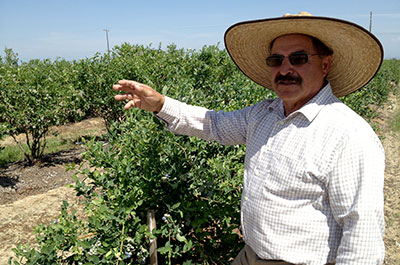
Credit: Alec Rosenberg
The postharvest facility is “extremely important” in helping to document food safety, added commission member Joel Nelsen, president of the California Citrus Mutual.
A field tour highlighted two crops in which UC has played a pivotal role: blueberries and pistachios.
Twenty years ago, few blueberries were grown in California. Blueberries were considered a cool-weather crop, but UC Cooperative Extension advisor Manuel Jimenez had a hunch they could grow here. He tested different varieties and found that blueberries could thrive by acidifying the soils and maintaining acidic conditions in the irrigation water. California is now one of the leading producers of fresh blueberries, with growing concentrated in the Central Valley.
“Blueberries love warm weather,” said Jimenez, who retired last year but still conducts blueberry research.
Pistachios have become an increasingly important crop, valued above $1 billion a year. The United States is the world's leading pistachio producer, and 99 percent of the country's crop comes from California. Half of all pistachios in California are grown on rootstock taken from the mother pistachio tree at Kearney, said UC Cooperative Extension specialist Louise Ferguson.
UC research has helped ensure the safety of pistachios through biological controls, said Themis Michailides, a UC Davis plant pathologist based at Kearney.
Napolitano noted that she made the ANR vice president a direct report to her because agricultural issues matter to California and the world.
Dealing with drought
Those issues include the drought. UC is putting its expertise to work, hosting 35 drought workshops in the past two months alone for farmers, ranchers and homeowners, said Doug Parker, director of UC ANR's California Institute for Water Resources, who served as a tour guide for the president.
UC researchers have come up with recommendations to help farmers minimize water use while maximizing production, said UC Cooperative Extension advisor Roger Duncan. Still, it's estimated that up to 10 percent of California's farmland could be fallowed, primarily in the San Joaquin Valley.
“A lot of lower-value crops just won't be planted,” Duncan said.
The daylong briefing reinforced how UC is at the forefront of issues facing California agriculture, said Barbara Allen-Diaz, UC vice president for ANR.
“It's great to see the incredible depth and breadth of California agriculture, and show the link between UC research and extension and the development of agriculture in the state,” Allen-Diaz said.

UC President Janet Napolitano discusses California agriculture on an aerial tour with farmer Don Bransford, who chairs the President's Advisory Commission on Agriculture and Natural Resources. credit: Doug Parker
UC researchers screen promising new winegrapes at Kearney
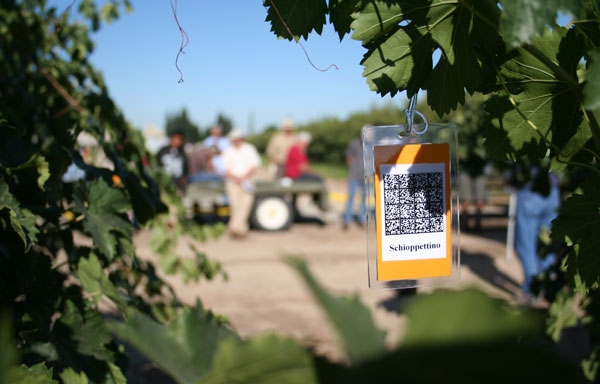
The research aims to give vintners blending varieties that will make San Joaquin Valley wines with familiar names more interesting. Vintners may use up to a quarter of their grape volume to impart distinctive color, flavor and structure to a varietal wine without calling it a blend. Grapes being studied at Kearney may one day add a certain flavor note - such as cherry, tannin, black pepper or citrus - to fine San Joaquin Valley wine.
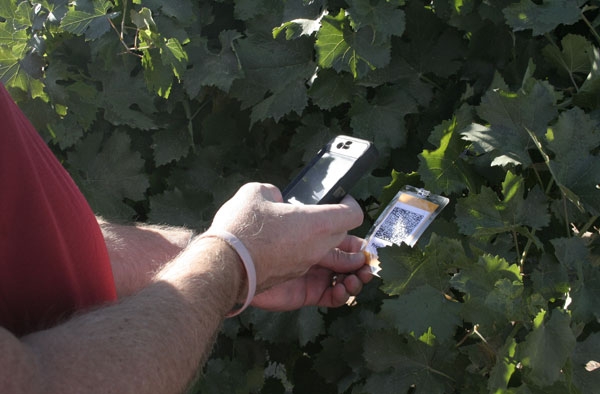
"High levels of color and tannin cannot compensate for a variety whose yield is far below the economic threshold," Wolpert said.
At another stop on the Grape Day tour, UC Cooperative Extension viticulture farm advisor Mark Battany demonstrated the "Paso Panel." Battany developed the tool - composed of an inexpensive, lightweight solar panel and digital meter mounted on an aluminum frame - to help farmers fine tune their irrigation scheduling.
The Paso Panel allows farmers and researchers to quickly and easily calculate the amount of canopy shade in a vineyard or a vineyard row. The data can be combined with climate data to calculate crop water needs.
Measuring soil moisture and using plant-based monitoring systems are other ways to determine plant water needs, but Battany said currently climate-based methods are underused.
"A lot of farmers guess when they need to irrigate," Battany said. "People tend to guess on the conservative side, and put on more water than necessary."
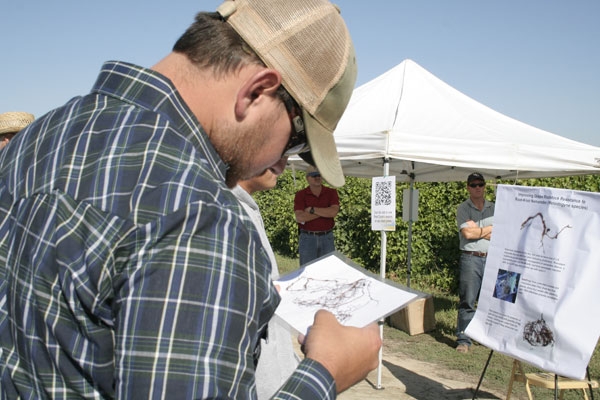
New York-based USDA-ARS plant breeder Peter Cousins was also at the field day to explain his grape root stock variety trials planted at the Kearney Agricultural Research and Extension Center. Cousins and his staff screen 3,000 to 4,000 seedlings a year. The best prospects are sent to California, where 140 experimental root stocks are growing.
"Here at Kearney, the vines grow so vigorously, we can get more than 100 cuttings per plant," said Cousins. "This is their last stop, where we determine whether you can grow them in a field and make wood that propagates vines."
Posters for Kearney Grape Day, August 16, 2011
Peter Cousins of the USDA-ARS in Geneva, N.Y., will be referring to these charts during his presentation at Kearney Grape Day. The title of Cousins' presentation is "The development of new grape rootstocks for the San Joaquin Valley."
Nematode poster (pdf)
Rootstock selections poster (pdf)
Kearney Grape Day 2011: Scientist to lead tour through the inside of grapevines
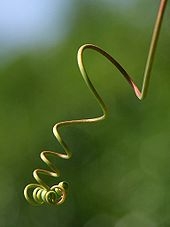
USDA plant biologist Andrew McElrone is using high resolution computed tomography – a type of cat scan similar to the medical imaging diagnostic system – to cruise through plant veins and vessels to better understand grapevines’ water transport system.
The research is conducted on live and dry grapevines at the Lawrence Berkeley National Laboratory. Like in medicine, each cat scan produces numerous digital slices of grapevine, which are stacked on top of each other using special engineering software to reconstruct the system.
“We can then spin the images around into various orientations, moving through individual vessels,” McElrone said.
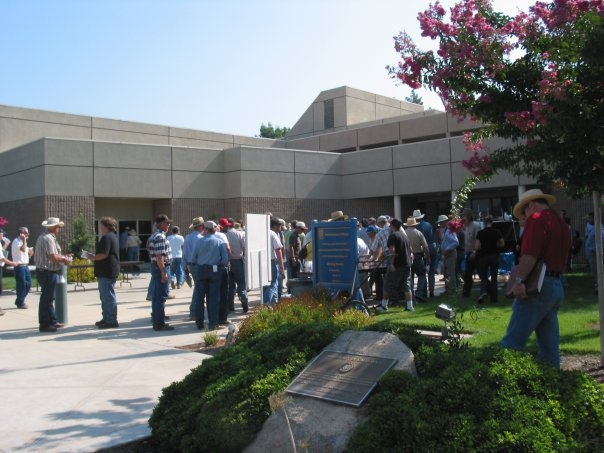
Grape Day registration begins at 7:30 a.m. Aug. 16 at the Kearney Agricultural Research and Extension Center, 9240 S. Riverbend Ave., Parlier, Calif. Field tours are conducted from 8 to 9:30 a.m. and classroom presentations will be from 10 a.m. to 12 noon.
Registration is $10 per person. Advance registration is offered online.
Field tour topics are:
- New wine grape varieties for the San Joaquin Valley by UC Cooperative Extension viticulture specialist James Wolpert, UC Davis
- The development of new grape rootstocks for the San Joaquin Valley by geneticist Peter Cousins, USDA-ARS, Geneva, N.Y.
- Using the ‘Paso Panel’ to aid in irrigation scheduling by viticulture farm advisor Mark Battany, UC Cooperative Extension, San Luis Obispo County
Classroom presentations:
- Understanding water use of grapevines by plant biologist Andrew McElrone, USDA-ARS, Davis, Calif.
- Trapping and baiting for gopher control in vineyards by vertebrate IPM advisor Roger Baldwin, Kearney, Parlier, Calif.
- Critical weed free periods in vineyard development by vegetation management farm advisor Kurt Hembree, UC Cooperative Extension in Fresno County
- Fruitfulness of DOV raisin cultivars by UC Cooperative Extension viticulture specialist Matthew Fidelibus, UC Davis and Kearney.
For more information, contact event coordinator Matt Fidelibus, mwf@uckac.edu, (559) 646-6500.
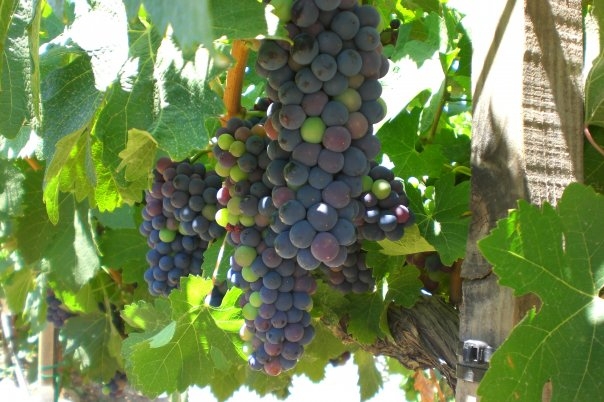
In a presentation that harkens back to the old Disneyland ride "Adventure Thru Inner Space," a USDA scientist takes participants on a tour inside of grapevines.
Charlie Summers: Outstanding in His Field
Charles "Charlie" Summers is outstanding in his field. And come Monday, March 30, the Pacific...

Charles Summers